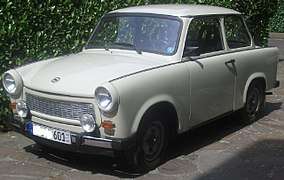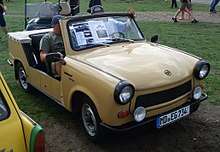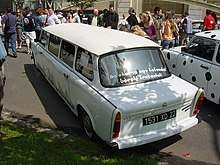Trabant 601
The Trabant 601 (or Trabant P601 series) was a Trabant model produced by VEB Sachsenring in Zwickau, Saxony. It was the third generation of the model, built for the longest production time, from 1963 to 1990. As a result, it is the best-known Trabant model and often referred to simply as "the Trabant" or "the Trabi". During this long production run, 2,818,547 Trabant 601s were produced overall and it was the most common vehicle in former East Germany.
| Trabant 601 | |
|---|---|
 Trabant 601 in 1963 | |
| Overview | |
| Manufacturer | VEB Sachsenring |
| Also called | Trabbi |
| Production | 1963–1990 |
| Model years | 1964–1990 |
| Assembly | Zwickau, Germany |
| Body and chassis | |
| Class | B-segment |
| Body style | 2-door saloon (Limousine) 2-door estate (Universal) Doorless ATV (Tramp) |
| Layout | FF |
| Platform | Trabant P601 |
| Related | Wartburg 353 |
| Powertrain | |
| Engine | P 6x (Otto, 594,5 cc, 19,1 kW) |
| Transmission | 4-speed manual |
| Dimensions | |
| Wheelbase | 2,020 mm (6 ft 8 in) |
| Length | 3,555 mm (11 ft 8 in) |
| Width | 1,505 mm (4 ft 11 in) |
| Height | 1,440 mm (4 ft 9 in) |
| Curb weight | 615 kg (1,356 lb) |
| Chronology | |
| Predecessor | Trabant P60 |
| Successor | Trabant 1.1 |
Overview

In hindsight, the Trabant 601 can be considered East Germany's answer to West Germany's "People's Car", the VW Beetle.[1][2] Its purpose was to provide a cheap but still reliable car that was very affordable and also easy to repair and maintain. Still, it was at the time of its release rather modern in many ways, with front wheel drive, a low maintenance engine, unitary construction, composite bodywork and independent suspension all around. The main letdown was the pre-war DKW based engine that was competitive when launched, but from the late 1950s into the 1960s, small economy cars in western countries that used two-stroke engines were replaced with cleaner and more efficient four-stroke engines, as employed from the start in the Volkswagen Beetle. Two-stroke engines of this sort, with crankcase scavenging and lubricating oil provided during fuel intake, burn their lubricating oil by design and produce smoky tailpipe emissions. However, two-stroke engines were also to be found in cars like the Western German Auto Union 1000 that ended production in 1963, and the Swedish Saab 96 that changed to four-stroke in 1967. The lack of development funds in East Germany forced the continued use of a two-stroke engine in the Trabant, thus causing this vehicle to become obsolescent in the 1960s and extremely obsolete by the 1980s.
History
The Trabant 601 was a modern automobile when introduced in 1963, with 150 pre-production examples. The body was modified from the previous P50/P60 variants of the Trabant, with a heavy emphasis on the front and roof area. The back of the car was also modified with different taillights and a higher trunk loading height as compared to previous models. Overall, the design was praised, particularly on the then-modern double trapezoid design. Originally, production was only planned to run from 1967 to 1971, but instead continued until 1990. The original engine was only 17 kW (23 hp), but in 1969, a new version was offered with a 19.1 kW (26 hp) engine. In 1974, a needle roller bearing was added to the connecting rod, allowing for a 50/1 lubricant to be used. Through the addition of a 2-stage carburetor in 1984, the fuel consumption was brought down by 1/100 l/km. With these additions, the top speed was measured to be 107 km/h.[3] Even with these improvements, the fuel consumption could still rise rapidly with extended acceleration or when towing a trailer. The P601 also had an overrunning clutch when running in 4th gear.
Over the course of decades, the design of the Trabant changed little. This caused the increasingly obsolete Trabant's reputation to worsen as time progressed. However, this had little effect on the sales figures — wait times of 10 years or longer for a new car were not uncommon. The price for a new Trabant in 1985 was 8,500 Mark for the 601 Standard, and 9,700 Mark for the most expensive model, the 601 Universal S de Luxe.[4] Available options at this time included a shelf under the instrument panel, intermittent windshield wipers and hazard flashers.
New models were considered with the P602, P603, and P610 being planned in Zwickau. Among other improvements researched were larger motors such as the Wankel engine. All improvements however were blocked by the GDR government, which considered them unnecessary and feared extra costs.
When a successor, the Trabant 1.1, was eventually developed, it had very minimal external differences. At first glance, the only changes were a new radiator grille, and the movement of the fuel cap to the rear right of the car. Upon closer examination however, the interior was subject to many changes.
Variants


- Trabant 601 Standard (as Limousine & Universal).
- Trabant 601 S (Sonderwunsch - Special Edition) With optional equipment like fog lamps, rear white light and an odometer (as Limousine & Universal).
- Trabant 601 DeLuxe. Like the 601 S and additional twin-tone colouring and chrome bumper (as Limousine & Universal).
- Trabant 601 Kübel (added in 1966). Jeep version with no doors, folding roof, auxiliary heating system, ignition system is RFI shielded.
- Trabant 601 TRAMP (added in 1978). Civilian version of the Trabant Kübel, mainly export to Greece.
- Trabant 601 Hycomat (P601 H), 1965–1990, in limited numbers (as Limousine & Universal). Made only for users with missing or dysfunctional left leg. It had included an automatic clutching system.
- Trabant 800 RS. Rally version (1986–1988) with 771 cc engine and 5-speed manual transmission.
Technical data
| Trabant 601 saloon | Trabant 601 Universal | |
|---|---|---|
| Engine: | Two cylinder two stroke otto engine type P65/66 | |
| Displacement: | 594.5 cc (36 cu in) | |
| Bore × Stroke: | 72 mm × 73 mm | |
| Rated power: | 19.1 kW at 4200 rpm | |
| Torque: | 54 N·m at 3000 rpm | |
| Compression ratio: | 7.8 ± 2 : 1 | |
| Cooling system: | Air-cooled | |
| Clutch: | Single disk dry clutch | |
| Gearbox: | Four-speed gearbox 1st gear: 4.08 2nd gear: 2.32 3rd gear: 1.52 4th gear: 1.103 Reverse gear: -3.83 | |
| Fuel type: | "Regular" gasoline 88 RON | |
| Oil type: | Two stroke engine oil MZ-22 | |
| Fuel-oil-ratio: | 1 : 50 | |
| Weight: | 615 kg | 650 kg |
| Dimensions L × W × H: | 3555 mm × 1505 mm × 1440 mm | 3560 mm × 1510 mm × 1440 mm |
| Top speed: | 100 km/h (62 mph) | |
| Source: | [5] | |
Export countries
Eastern Europe
Western Europe
The 601 today


Many former DDR citizens have mixed emotions in regards to their "Trabi", which still is a symbol for the demised DDR,[6] since it was a part of the system.[7] In recent years, these distinctive cars have become collectors' items, with growing popularity. Green Trabants are especially popular, as they are rumoured to bring good luck to their owners. Many Trabant owners' clubs exist throughout Europe and 601s have their fans all over the world.[8] Also, many Trabant 601s are still used as rally racing cars.
As a symbol for a forgone era, it has inspired movies such as Go Trabi Go that presented the Trabi as a kind of East German character and could make former DDR citizens laugh "not precisely at themselves, but at the absurdities of the system under which they lived until last year," symbolised by the three main aspects of the Trabant: slow, breaks down frequently and often ridiculed by Western society.[9] It has also seduced people like the American actor David Hasselhoff to drive a "Trabi", although he had trouble to getting into it.[10] Stephen Kinzer of The New York Times likens the Trabi as a symbol for the people who built it, who “survive[d] through difficult times and ultimately triumph[ed]”.[9] The car was also featured in the American film Everything Is Illuminated.[11]
The Trabant 601 is the subject of Jalopy, a 2016 roadtrip video game. Set in June 1990 East Germany, during the early months of German reunification, the player is tasked to maintain a fictionalized version of the Trabant 601, the Laika 601, and eventually drive the player character's uncle using the car to Istanbul, Turkey, via Eastern and Southeastern Europe.[12]
References
- "The Trabant was East Germany's answer to the peoples car as the Volkswagen Beetle was to West Germany". Retrieved 2011-05-02.
- "It's the VW Beetle of Eastern Europe". Retrieved 2011-05-02.
- "Trabant 601". Der Deutsche Straßenverkehr. 12. 1984.
- "Preis im Januar 1985 (inkl. ein Jahr Haftpflichtversicherung)". Fluter. 30: 21.
- Sachsenring (ed.), Betriebsanleitung für den Personenkraftwagen Trabant 601 (PDF) (in German), Leipzig: Fachbuchverlag, pp. 62–66
- Rodden, John (2002). Repainting the Little Red Schoolhouse: A History of Eastern German Education, 1945-1995. Oxford University Press. p. 176. ISBN 9780195112443.
- "The Trabant was, from the point of view of the East German leadership and its bureaucracy, part of a larger, overarching "system of movement"". Retrieved 2011-05-02.
- "These once forlorn vehicles from Eastern Europe enjoy a nostalgic revival all over the world". Archived from the original on 2011-05-01. Retrieved 2011-05-02.
- Kinzer, Stephan (March 7, 1991). "CHEMNITZ JOURNAL; That Good-for-Nothing Car Is Good for a Laugh". The New York Times. Retrieved 2009-11-03.
- "It is really funny how he barely could fit inside". Retrieved 2011-05-02.
- "Trabant 601 Trombi/Estate featured in Everything is Illuminated". Internet Movie Database. Retrieved 2010-10-22.
- "Jalopy". Valve. Retrieved 2016-06-13.
External links
| Wikimedia Commons has media related to Trabant 601. |